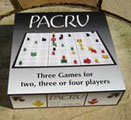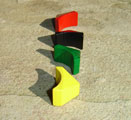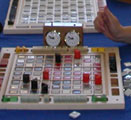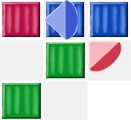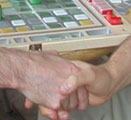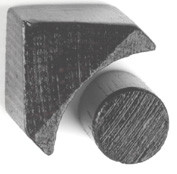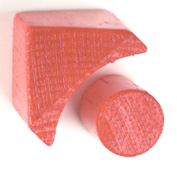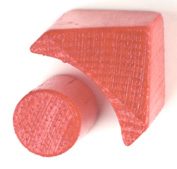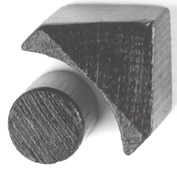Azacru® was invented in 2005 (or so the author claims) and first published together with Pacru and Shacru in
October 2005 (the series 302 board). For images of the game kit click here.
Mike writes about Azacru (and just can't avoid comparing it to Pacru) (2011):
Which is the game that I play most often? Azacru. I do like Pacru very much indeed, and to draw on an extravagant literary metaphor, at the beginning of a game I feel like I'm about to embark upon a large 19th century Russian classic novel. I'm entering a world where I'm going to be spending some time (unless I'm playing one of the game's medal-winners, in which case the game may turn out to be a very short story - perhaps part of the reason I was pleased with the acceptance of the 2011 rule change that prevented very early "meetings" which could facilitate an early end). There can be major turning points at various intervals in the game - a strategy that is working well can be upset by a sudden turn of events in which a chevron is removed from the board, or a key marker removed by an unforeseen meeting. However I'm not always in the mood for Pacru and I've not always got time for Pacru. Azacru seems to be intrinsically a fast game - even when played against clocks at the World Championships players very rarely have any issue with time (whereas there are occasional championship games of Pacru where time becomes a deciding factor instead of merely a constraint, and one wishes players who have managed to retain a rough parity over the course of an hour could carry on spending more time to think about their moves).
So Azacru is fast, and often that is both convenient and appropriate to the situation in which the game is happening (lunchtime in the Didsbury pub, "The Fletcher Moss" for instance). The situation of play also changes quite rapidly, but not randomly. Sometimes I play Azacru and get some fixed ideas in my head about what I'm going to do - build up some power in these regions, get some markers to jump to in these regions etc - and if I stop even for a few moves paying attention of my opponent's moves (even those these may not appear to directly affect me) I can miss opportunities much more rewarding than those I was thinking of, and miss threats that could soon ruin my plans. So it is a game that rewards the nimble player, the one who really pays attention to what their opponent(s) are doing and is willing to jettison their previous plans from moment to moment.
I used to play bass guitar in bands, and sometimes we'd have a jam before rehearsing songs, or sometimes we'd have improvised sections when playing live. I could find myself on occasion with ideas in my head for something I'd done before, or something I'd like to try and those could get in the way of what was happening because I was too attached to them, and not going with the flow. In Azacru you have to go with the flow - recognise the dangers, get a feel for the opportunities.
Azacru is a game that can come to a relative rapid conclusion, and the feeling that the conclusive period is about to start rises as the game goes on - the tension builds and builds. In Pacru the tension rises and falls - the start can be enormously tense (sometimes too tense for me if I'm tired after a long day's work and playing a wide awake opponent looking for a quick win), then it can settle down to a period of territory building, then the opportunities for long distance capture by pincer can again make it more tense, and specific periods when rival chevrons are perhaps going round the board in opposite directions and meeting each other, or one set is following on closely behind another can be followed again by several moves without much fear.
The feeling of waiting for the time to start into the period of "finishing off" - when one can hopefully manage several colour-removal connection change moves (I really should have thought of a proper name for that) in succession and remove all one's chevrons off the board - is exciting. It is matched by rising tension at the thought that someone else is about to do the same to you.
Strangely I very rarely count the markers in Azacru until the game is over, just relying on feelings about whether the game is roughly at level pegging or going one way or the other.
I have said it before, but if I were marketing the games anew, I would have called the game set "Azacru". I feel I've done a disservice to this game by letting it be overshadowed by Pacru! I would like to counter any suggestion that this is because I managed to get the 1st Azacru World Championship gold, and have never had that success with Pacru. Seriously it does sadden me when I realise that people get the 302 game set, and think that Shacru & Azacru are just training games or cut-down versions of Pacru. I like Shacru, and think it is fine as a game of its kind (blocking) but to be honest it would not break my heart if I never played another game of it. Anyone who loves abstract games and gets a Pacru 302 set and ignores Azacru is I think missing out on something that would give them a great deal of pleasure (and also they could well find a wider set of possible opponents amongst family and friends who turn away from the idea of mastering the Pacru rule set!!).
Mike Wellman 30th July 2011.
Photos of a complete Azacru game in 20 turns
Test edition of Azacru software. If you've played Shacru then half of Azacru will be familiar ... but a very important half won't be ... so browse the rules first. Don't try this game if it would upset you in the unlikely event that the software
doesn't work or fails near the end of a game!
Known faults:
1) if get 42 tiles game ends ... should continue to max
2) game log is Pacru style and game replay doesn't work
3) when a piece jumps over opposition tiles and disappears it would be nice if
it flashed first rather than just disappearing!
|
|
Red has caused an early end to the game with some good connection changes and black could not catch up on markers on the final round
|
|
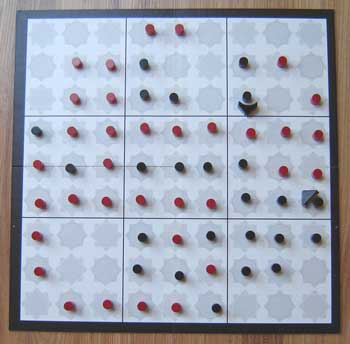
|
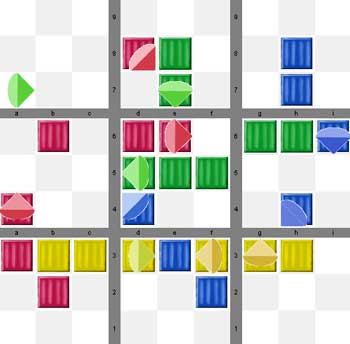
|
|
|
A four player game in the early stages but already a few connection changes across opposition markers would be possible if they were not prevented by other chevrons being on the squares the connection move would travel across (red chevron prevents connection change by green chevron) or, in the case of yellow, chevrons already occupying the destination square.
|



